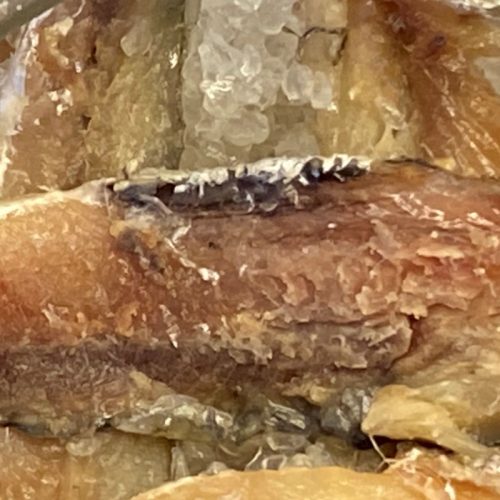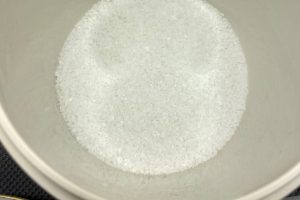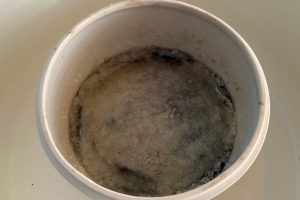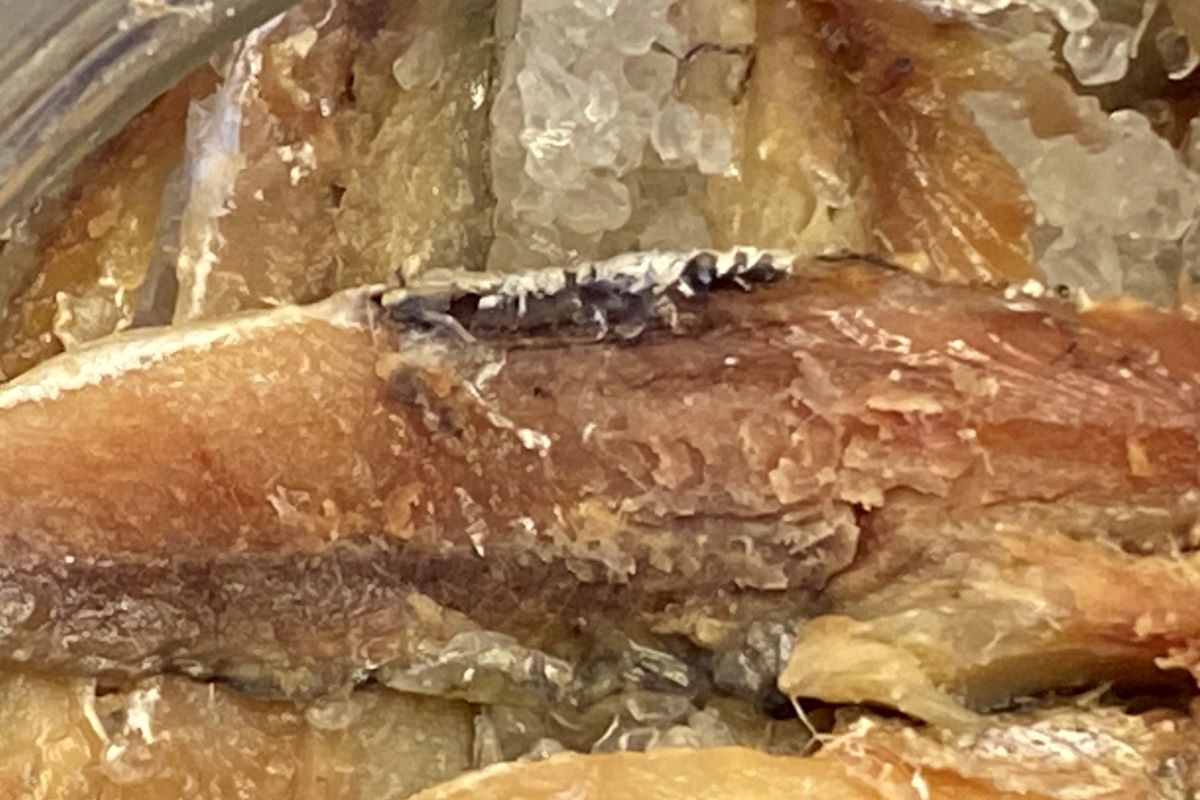Salt cured anchovies should be an essential part of your food base. Anchovies are the most eaten fish in the Mediterranean region, but also far beyond. Salt cured and fermented anchovies are great on pizza, but also as a separate appetizer and as a base ingredient that gives Mediterranean sauces that special taste. A salt cured anchovy fillet wrapped around an olive is a healthy, hearty and delicious snack. It is the ultimate umami taste provider.
The art of making salt cured anchovies
Anchovies contain around 75 % water. The curing action of salt is based on the dehydrating effect on the fish cells, as well as on bacteria. So the salt will extract water from these cells as will be shown from a layer of brine that forms on top of the fish after a day. At the same time some ripening will take place. Enzymes that occur in the guts of the fish accelerate this ripening process. But gutted fish also ripen well, possibly because active enzymes remain always behind.
There are several pointers for a successful cure. Always use fresh or freshly frozen anchovies. And to virtually eliminate any chance on botulism, best to clean the fish entirely before salting it. But in Italy, Greece and Turkey the locals only decapitate the fish and take most of the entrails with it. They take out the backbone and clean remaining parts after the cure. Also ensure the fish is always covered by brine and salt during the curing. Use a weight on top of the fish! And temperature should be between 15 and 23 C during the ripening process.
Some have recommended 2 weeks in the fridge is sufficient, but taste is developed over months. So use 3 months at room temperature and thereafter finally clean the fish and store the salted fillets into the refrigerator. By then most anchovies fillets will have started to obtain a beautiful red hue. And covered by brine and salt the fish staple can be kept for over a year in the fridge. But that never happens in my kitchen.
Special equipment
- 1 quart (1 liter) sized porcelain or ceramic glazed pot
- inert flat round material on which a large weight can be placed

Salt cured anchovies
Ingredients
Ingredients for the curing
- 1 1/4 lb sea salt (1/4 lb to make brine for rinsing)
- 2 lb fresh or freshly frozen anchovies (1 lb after de-heading and gutting)
- 1 quart (liter) water
Instructions
Instructions to fill the salting pot
- Handle the fish as soon as possible after the catch and keep cold at all times. Place the fish in (dilute) brine until they can be gutted and cleaned. Use 3.5 ounces (100 g) salt per liter water
- Clean each fish: keep the fish just under the head with thumb and index finger and with these fingers of the other hand turn the head and pull the entrails with it.

- In the one quart sized pot, place a layer of coarse sea salt (or coarse rock salt as you like) on the bottom

- Please a first layer of anchovies on the salt layer
- Cover the layer of fish with a thin layer of salt
- Then place cross layers of cleaned anchovies, every time covering each layer with salt
- Finalize with a thicker layer of salt

During the curing
- Place a flat, wooden or plastic round cover on the salt layered fish, so that a weight can be placed on top. Leave some space to have an open connection with the air. We use around 0.5 psi or 0.04 kg/cm2 pressure on the salted fish. This is the weight of 8 pounds on a surface area of 16 inch2. Weighting the salted fish is essential to keep air pockets out

- The next day, a clear layer of brown-yellowish brine is visible on top of the layered fish: the salt is extracting the water from the cells

- On subsequent days more brine is visible. Ensure there is always solid salt and brine present on top. Should you prefer to refresh some of the brine, always cover the fish with saturated brine and with solid salt present. The brownish brine becomes extremely tasty over time, rich with umami tasting amino acids: use it as fish sauce in recipes
- After some 3 months, take the weight off and clean each fish by cutting the bottom open from the tail end. Usually only some remaining intestines and the back bone need to be removed
- Place the fillets covered with salt and saturated brine in glass jars in the refrigerator. The fillets can be stored for over a year in this brine
- To use, place some fillets of anchovies in water or milk for around 5-20 min. Check one for taste and saltiness level during this process. If needed refresh the water or milk and do it again. But be careful not to desalt too much as the fillets may become soft and mushy. Thereafter dry the fillets on a kitchen paper towel for a few minutes and use. The partially desalted fillets may be stored for several months under olive oil or used for a snack or starter.
Notes
Food allergy & intolerance information: fish
Remarks
- Use pure sodium chloride, not “Low” salt that consists for a large part of potassium chloride. We need to create the highest osmotic pressure possible, high salt solubility in water and small ions (the latter for the chemists under you).
- The FAO has described that when using fresh, but not completely gutted, fish the chance on botulism is virtually zero. The FDA , however, has issued a bulletin that recommends to completely gut the fish before salt curing it. I have used both ways without a problem. In this recipe we remove the bulk of the guts before salting.
- In this recipe we use (gutted) fresh fish to salt ratio of 1:1, the most rigorous, salty conditions where living cells will not survive for long. When operating in a fish to salt ratio range of 2:1 to 6:1, a more active fermentation will occur as salt loving bacteria will join the fest! Under these conditions fish sauce is produced, where the flesh is totally disintegrated. The process for that is longer, up to one and a half year.
- Before using the anchovies in your cooking, place the fillets in milk or water for 5-20 minutes to lose some of their salt. You must experiment with the time. Alternatively repeat once or twice. After the desalting step, dry the fillets briefly on a piece of kitchen paper. Thereafter use the fillets or store under olive oil in the fridge for several months.



